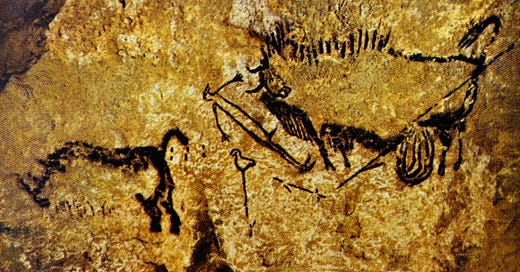If you enjoy this content, if you find it meaningful to you, we encourage you to become a paid member for $3/mo! With a paid subscription, you get access to all of my four of my previously published and award-winning books (digital and audiobook versions) and so, so much more! It may be a cup of coffee for you, but it is the nourishment that keeps up alive, and we are so very thankful!
This chapter of Stagtine: Kincentric Rewilding, my latest book that we are dripping here on Unshod, is provided for all PAID members.
To view a full (slowly released) Table of Contents to Stagtine, my latest book made available to you all in both paperback, digital, and audiobook formats, click here!
You can also purchase all the versions of Stagtine on Amazon or our website.
To read the previous chapter:
Awakening the Cave
If uniform agriculture is the equilibrium of our civilized, false age, then what about the husbandman’s herds and their regenerative mythology of mobbing, mowing, and moving animals? First, we must understand the myth.
In 2014, I wrote a biography of Daniel Boone, the American woodsman, for my academic thesis.1 I wrote it, in part, because I was interested at that time in our culture’s beginnings. Boone is the popular image of American expansion and he opened the west for white colonization.
I wanted to find out if that was actually true or just the constructed, hero mythology of our settler culture.
I had only recently returned from France’s glorious Dordogne Valley, where I was studying the Middle to Upper Paleolithic cave art of early hominins from Lascaux to Grand Roc to Les Combarelles. Our work partnered with Oniris, the Nantes-Atlantic National College of Veterinary Medicine, Food Science and Engineering and we sought to slowly unpack the life, genetics, and mythologies of early humanity through their enigmatic arts and to consider why ancient humans painted animals such as horses, bison, mammoths, aurochs, lions, bears, deer, and wolves on deep and dark cave walls. Hunter-gatherers, history tells us, had no time for leisure or art or even to progress their phonology into a “true” ethnicity—stability through a written language.2 They had no time for artistic or civilized expression, only survival. But they did paint and they painted well and painted a lot.
I wanted to learn if that was actually true or just modern mythology welling up, like crude oil, from our incessant industry and indelible mastery.
The Bison-Bird-Man of Lascaux
Often called the Versailles of Prehistoric Man, Lascaux ranks as one of the world’s oldest and grandest art galleries. Over two thousand paintings decorate seven galleries. The late Norbert Aujoulat, who studied these paintings for over thirty years and published Lascaux: Le Geste, l'espace et le temps or Lascaux: Movement, Space and Time, argued that each of the cave’s major panels comprise a calendar of rutting—a seasonal sensation of cross-fertility. Aujoulat revealed that the major animals in every panel were depicted in their rutting coats: auroch bulls donning thick head hair (representing summer), hulking horses red and brown with tails reaching the floor (representing spring), stags bursting in the red carrying large antlers (representing autumn), and bison warm but thin under their winter coats (representing winter).3
Keep reading with a 7-day free trial
Subscribe to Unshod to keep reading this post and get 7 days of free access to the full post archives.






